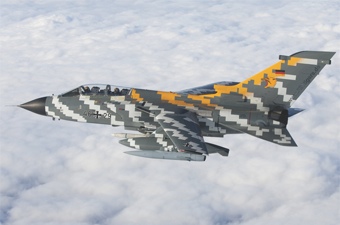As fascinating as its name is bland, “the New Aesthetic” refers to a website launched in 2011 by the London-based artist, designer, and writer James Bridle; to the many images archived on that site; to Bridle’s argument about the sensibility that those images share; to the international panoply of pictures, websites, texts, and computer programs created in response; and to a heated debate about what they mean. The New Aesthetic instructs us to look to the future, but it might be most interesting for what it says about the recent past.
Put too simply, the New Aesthetic is an art movement, or an attempt to launch one, that welcomes human collaborations with real or imagined digital machines. The earliest pictures on Bridle’s site were either real objects that looked like crude programmed creations, or digital images whose oddball features put their difference from “real life” up front. Coarse green squares in an arid, tan landscape looked like early-’80s Atari graphics but were really “agricultural land seen from space.” A pendulous, blue-on-blue column of LEGO-like blocks, representing water, “poured” out from a New York City pipe. Later works included imaginary buildings shaped like QR codes, an essay about Auto-Tune, and much reuse of Google Street View.
In such vistas, to use Bridle’s words, “representations of people and of technology begin to break down… at the pixels.” We are already cyborgs, these images say, and we should know it; digital vision and computer-assisted perception have become so normal that we need new art to show how weird they can be.
Proponents cast the movement as anti-nostalgic, opposed to the idea that we are fake or artificial or compromised now but were real or organic or natural—and therefore more interesting or sympathetic—back then. Au contraire, the New Aesthetic says: we are as real as we have ever been, even though for us the real, the visible, the everyday involve so many algorithms and so many machines. Bridle says he wants to attack “the belief that authenticity can only be located in the past.”
And yet New Aesthetic images and attitudes also point to that past. Those blocky grid breakdowns, those crude maps and repurposed texts, invoke the 1980s and 1990s; once, these were the best computers could do, and it’s their very obsolescence that lets us register them as other than useful: as “aesthetic,” or as beautiful. With its eight-bit graphics, its cut-up...
You have reached your article limit
Sign up for a digital subscription and continue reading all new issues, plus our entire archives, for just $1.50/month.
Already a subscriber? Sign in





